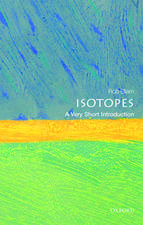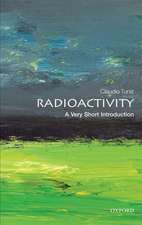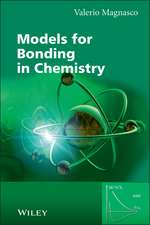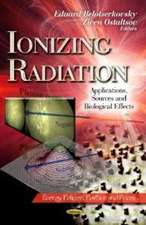Handbook of Nuclear Chemistry: Vol. 1: Basics of Nuclear Science; Vol. 2: Elements and Isotopes: Formation, Transformation, Distribution; Vol. 3: Chemical Applications of Nuclear Reactions and Radiation; Vol. 4: Radiochemistry and Radiopharmaceutical Chemistry in Life Sciences; Vol. 5: Instrumentation, Separation Techniques, Environmental Issues; Vol. 6: Nuclear Energy Production and Safety Issues.
Editat de Attila Vértes, Sándor Nagy, Zoltán Klencsár, Rezso György Lovas, Frank Röschen Limba Engleză Hardback – 10 dec 2010
The international team of authors consists of scores of world-renowned experts - nuclear chemists, radiopharmaceutical chemists and physicists - from Europe, USA, and Asia. The Handbook set is an invaluable reference for nuclear scientists, biologists, chemists, physicists, physicians practicing nuclear medicine, graduate students and teachers - virtually all who are involved in the chemical and radiopharmaceutical aspects of nuclear science.
The Handbook set also provides further reading via the rich selection of references.
Preț: 15322.20 lei
Preț vechi: 20160.79 lei
-24% Nou
Puncte Express: 22983
Preț estimativ în valută:
2932.00€ • 3075.23$ • 2440.76£
2932.00€ • 3075.23$ • 2440.76£
Carte tipărită la comandă
Livrare economică 28 martie-03 aprilie
Preluare comenzi: 021 569.72.76
Specificații
ISBN-13: 9781441907196
ISBN-10: 144190719X
Pagini: 3440
Ilustrații: CCXVI, 3008 p.
Dimensiuni: 155 x 235 x 212 mm
Greutate: 3.36 kg
Ediția:2nd ed. 2011
Editura: Springer Us
Colecția Springer
Locul publicării:New York, NY, United States
ISBN-10: 144190719X
Pagini: 3440
Ilustrații: CCXVI, 3008 p.
Dimensiuni: 155 x 235 x 212 mm
Greutate: 3.36 kg
Ediția:2nd ed. 2011
Editura: Springer Us
Colecția Springer
Locul publicării:New York, NY, United States
Public țintă
ResearchCuprins
Volume 1:
Nuclear and Radiochemistry: the First 100 Years.- Basic Properties of the Atomic Nucleus.- Nuclear Reactions.- Nuclear Fission.- Fission Through Triple-Humped Fission Barriers.- Nuclear Fusion.- Kinetics of Radioactive Decay.- Interaction of Radiation with Matter.- Stochastics and Nuclear Measurements.- The Standard Model of Elementary Particles.- Reference Data (Volume 1): The International System of Units (SI).
Volume 2:
Origin of the Chemical Elements.- Natural Radioactive Decay Chains.- Radioelements.- Isotope Effects.- Isotopic Paleoclimatology.- Radioactive Dating Methods.- Production and Chemistry of Transuranium Elements.- Production and Identification of Transactinide Elements.- Chemistry of Transactinides.- Superheavy Elements.- Table of the Nuclides (Volume 2).
Volume 3:
Radiation Chemistry.- Hot Atom Chemistry.- Mössbauer Spectroscopy.- Mössbauer Excitation by Synchrotron Radiation.- Positron Annihilation Spectroscopies.- Exotic Atoms and Muonium.- Neutron Scattering Methods in Chemistry.- Activation Analysis.- Neutron-Induced Prompt Gamma Activation Analysis (PGAA).- Applications of Neutron Generators.- Chemical Applications of Ion Accelerators.- Microscopic X-ray Fluorescence Analysis with Synchrotron Radiation Sources.- Tracer Technique.- Reference Data (Volume 3): Mössbauer Nuclides.
Volume 4:
Introduction to the Fourth Volume.- Reactor-Produced Medical Radionuclides.- Cyclotron
Production of Medical Radionuclides.- Radionuclide Generators.- 11C: Labeling Chemistry and Labeled.- Compounds.- 18F: Labeling Chemistry and Labeled Compounds.- 99mTc: Labeling Chemistry and Labeled Compounds.- Radioiodination Chemistry and Radioiodinated Compounds.- Radiometals (non-Tc, non-Re) and Bifunctional Labeling Chemistry.- Radionuclide Therapy.Volume 5:
Dosimetry and Biological Effects of Ionizing Radiation.- Radiation Detection.- Dosimetry Methods.-Particle Accelerators.- Isotope Separation.- Solvent Extraction and Ion Exchange in Radiochemistry.- Radiochemical Separations by Thermochromatography.- Methods of Cosmochemical Analysis.- Environmental Radiation Protection.- Reference Data (Volume 5): Standards for Detector Calibration.
Volume 6:
Technical Application of Nuclear Fission.- Developments and Tendencies in Fission Reactor Concepts.- Nuclear Power Sources for Space Systems.- Technical Developments for Harnessing Controlled Fusion.- Radioactive Waste Management.- Nuclear Forensic Materials and Methods.- Nuclear Safeguards Verification Measurement Techniques.
Nuclear and Radiochemistry: the First 100 Years.- Basic Properties of the Atomic Nucleus.- Nuclear Reactions.- Nuclear Fission.- Fission Through Triple-Humped Fission Barriers.- Nuclear Fusion.- Kinetics of Radioactive Decay.- Interaction of Radiation with Matter.- Stochastics and Nuclear Measurements.- The Standard Model of Elementary Particles.- Reference Data (Volume 1): The International System of Units (SI).
Volume 2:
Origin of the Chemical Elements.- Natural Radioactive Decay Chains.- Radioelements.- Isotope Effects.- Isotopic Paleoclimatology.- Radioactive Dating Methods.- Production and Chemistry of Transuranium Elements.- Production and Identification of Transactinide Elements.- Chemistry of Transactinides.- Superheavy Elements.- Table of the Nuclides (Volume 2).
Volume 3:
Radiation Chemistry.- Hot Atom Chemistry.- Mössbauer Spectroscopy.- Mössbauer Excitation by Synchrotron Radiation.- Positron Annihilation Spectroscopies.- Exotic Atoms and Muonium.- Neutron Scattering Methods in Chemistry.- Activation Analysis.- Neutron-Induced Prompt Gamma Activation Analysis (PGAA).- Applications of Neutron Generators.- Chemical Applications of Ion Accelerators.- Microscopic X-ray Fluorescence Analysis with Synchrotron Radiation Sources.- Tracer Technique.- Reference Data (Volume 3): Mössbauer Nuclides.
Volume 4:
Introduction to the Fourth Volume.- Reactor-Produced Medical Radionuclides.- Cyclotron
Production of Medical Radionuclides.- Radionuclide Generators.- 11C: Labeling Chemistry and Labeled.- Compounds.- 18F: Labeling Chemistry and Labeled Compounds.- 99mTc: Labeling Chemistry and Labeled Compounds.- Radioiodination Chemistry and Radioiodinated Compounds.- Radiometals (non-Tc, non-Re) and Bifunctional Labeling Chemistry.- Radionuclide Therapy.Volume 5:
Dosimetry and Biological Effects of Ionizing Radiation.- Radiation Detection.- Dosimetry Methods.-Particle Accelerators.- Isotope Separation.- Solvent Extraction and Ion Exchange in Radiochemistry.- Radiochemical Separations by Thermochromatography.- Methods of Cosmochemical Analysis.- Environmental Radiation Protection.- Reference Data (Volume 5): Standards for Detector Calibration.
Volume 6:
Technical Application of Nuclear Fission.- Developments and Tendencies in Fission Reactor Concepts.- Nuclear Power Sources for Space Systems.- Technical Developments for Harnessing Controlled Fusion.- Radioactive Waste Management.- Nuclear Forensic Materials and Methods.- Nuclear Safeguards Verification Measurement Techniques.
Recenzii
“This is a very complete particle physics textbook. Nuclear Medicine physics and radiation oncology have an entire volume devoted in this discussion background text. … This encyclopedia and principle resource should help nuclear physics specialists.” (Joseph J. Grenier, Amazon.com, September, 2015)
From the reviews of the 1st Edition:
"…[the Editors] have displayed a comprehensive vision… far more exhaustive than any of the existing books on nuclear chemistry and/or radiochemistry. … an impressive and fascinating work… the clear arrangement of the various topics, extensive indexes in each volume, a short summary at the start of each chapter, in most chapters the use of bold characters in the text when introducing a new concept, facilitate its use as a reference work. … appendices on units, physical constants, nuclear and atomic data, and reference materials enhance the usefulness… indispensable for students and researchers in the nuclear field at large. In addition,it is also useful for scientists from the disciplines of biology, medicine, physics, and chemistry, showing the wealth of nuclear and radiochemical methods to solve their problems and to achieve progress in their fields. "...The editors have chosen the title by the consideration that 'nuclear chemistry' and
'radiochemistry' have become practically synonymous....In the selection of topics they have displayed a comprehensive vision considering a large spectrum of topics, so that the handbook has become far more exhaustive than any of the existing books on nuclear chemistry and/or radiochemistry.... Due to the wide scope, the handbook has become an impressive and fascinating work, positioning nuclear fundamentals and methods firmly and clearly within the spectrum of pure and applied natural sciences. ...Each chapter forms generally a complete whole, keeping the balance steady between conciseness and completeness, and showing liveliness due to the varying writing style of the authors. ...The chapters quite often contain a short (historical) introduction, sometimes remarks about future developments or perspectives and at the end suggested further readings, in addition to a standard list of references. The clear arrangement of the various topics, extensive indexes in each volume, a short summary at the start of each chapter, in most chapters the use of bold characters in the text when introducing a new concept, facilitate its use as a reference work. The various appendices on units, physical constants, nuclear and atomic data, and reference materials enhance the usefulness of this handbook, and justify having this handbook close at hand. ...Altogether, due to the comprehensive character this handbook is indispensable for students and researchers in the nuclear field at large. In addition, it is also useful for scientists from the disciplines of biology, medicine, physics, and chemistry, showing the wealth of nuclear and radiochemical methods to solve their problems and to achieve progress in their fields....The handbook is a helpful basis for scientists to disseminate relevant and interesting information on nuclear topics to a large public. In particular showing that nuclear and associated radiation aspects are quite natural phenomena (human life on earth today would not exist without), and especially that mankind has benefited much and still may benefit in many respects from a variety of nuclear techniques and methods when properly use. ..." (Structural Chemistry (2005) by Jeroen J.M. de Goeij, Interfaculty Reactor Institute, Delft University of Technology & Cyclotron Group, Physics Department, Eindhoven University of Technology, The Netherlands)From the reviews of the 1st Edition:
"…[the Editors] have displayed a comprehensive vision… far more exhaustive than any of the existing books on nuclear chemistry and/or radiochemistry. … an impressive and fascinating work… the clear arrangement of the various topics, extensive indexes in each volume, a short summary at the start of each chapter, in most chapters the use of bold characters in the text when introducing a new concept, facilitate its use as a reference work. … appendices on units, physical constants, nuclear and atomic data, and reference materials enhance the usefulness… indispensable for students and researchers in the nuclear field at large. In addition,it is also useful for scientists from the disciplines of biology, medicine, physics, and chemistry, showing the wealth of nuclear and radiochemical methods to solve their problems and to achieve progress in their fields. "...The editors have chosen the title by the consideration that 'nuclear chemistry' and
"…No similar complete opera has ever been available on the editorial market. …of relevance for scientists dealing with radiation physics and chemistry, materials sciences, applied nuclear physics, biophysics, radiobiology, radiopharmaceutical chemistry, nuclear medicine, radiation protection, environmental sciences, and all fields in which the powerful energy of the atomic nucleus is required and advantageously utilized. … clearly written and completed with essential and updated specialized bibliography." (Radiation Chemistry and Physics (2005) by Mauro L. Bonardi, Coordinatore Gruppo Interdivisionale di Radiochimica LASA, Università degli Studi e INFN, Italy)
"…authoritatively surveys all of
the chemical aspects of the dynamic field of nuclear science…The international team of 77 authors consists of world-renowned nuclear chemists, radiopharmaceutical chemists, and physicists… contains hundreds of tables, figures, and mathematical and nuclear equations. … extensive selection of references … The international system of units (SI) is used consistently throughout the handbook…. Like many other Kluwer reference works, the Handbook of Nuclear Chemistry is available online. … an invaluable, comprehensive, and cutting-edge reference for nuclear scientists, chemists, biologists, physicists, physicians practicing nuclear medicine, chemical educators, graduate students, and anyone involved in the chemical and radiopharmaceutical aspects of nuclear science. It also belongs in academic, industrial, and technical libraries." (ChemoNet (2005) by George B. Kauffman, California State University, USA) "... much to offer undergraduate and graduate students who are interested in careers in radio/nuclear chemistry... Overall, these five volumes offer a uniquely comprehensive presentation of the major areas of research and technology in nuclear and radiochemistry. They offer students valuable instructions and, also, serve as an important reference source for research scientists." (The Journal of Radioanalytical and Nuclear Chemistry (2004) by G. R. C
hoppin, J. N. Mathur, D. K. Singh, M. S. Mallekav, & P. Thakur, Florida State University, USA) "The 20th century has been called the‘Nuclear Age’ … . Therefore the publication of the Handbook of Nuclear Chemistry, which authoritatively surveys all of the chemical aspects of the dynamic field of nuclear science is most welcome. … contains hundreds of tables, figures, and mathematical and nuclear equations. … The extensive selection of references … provides access to further reading in the field. … is an invaluable, comprehensive, and cutting-edge reference for nuclear scientists, chemists, biologists, physicists …. It also belongs in academic, industrial, and technical libraries." (George B. Kauffman, Chemical Educator, 2005
"The five volume set comprise … . Volume1 with eight chapters and an Appendix, discusses the history of nuclear and radiochemistry … . Volume 2 consists of ten chapters and covers the details of the radioactive elements … . Volume 3 is comprised of eleven chapters and an Appendix. ... Volume 4 consists of 10 chapters … . Volume 5 has nine chapters and a well compiled, informative Appendix. … these five volumes offer a uniquely comprehensive presentation of the major areas of research and technology in nuclear and radiochemistry. They offer students valuable instructions … ." (G.R. Choppin, J.N. Mathur, D.K. Singh, M.S. Mallekav, P. Thakur, Journal of Radioanalytical and Nuclear Chemistr
y, Vol. 261 (3), 2004) "The Handbook of Nuclear Chemistry … is written by well recognized stakeholders in the different topics, and has its main routes in chemistry and in nuclear science at large. It is mainly addressed to specialists in different nuclear fields, nonetheless it contains an advanced set of information for students at Ph.D. level … . The chapters are clearly written and completed with essential and updated specialized bibliography. A number of Appendices with numerical data, fundamental constants and nuclide tables complete the opera." (Mauro L. Bonardi, Radiation Physics and Chemistry, Vol. 72, 2005)
"I have these five volumes, each of which
Caracteristici
Unique in size and scope, covers the latest research of the chemical aspects of nuclear science. Includes a well summarized Table of the Nuclides in the Appendix - an excellent reference source. Written by an international team of world-renowned experts consisting of nuclear chemists, radiopharmaceutical chemists and physicists from Europe, Asia and USA. Key information for all those involved in chemical & radiopharmaceutical aspects of nuclear science.











